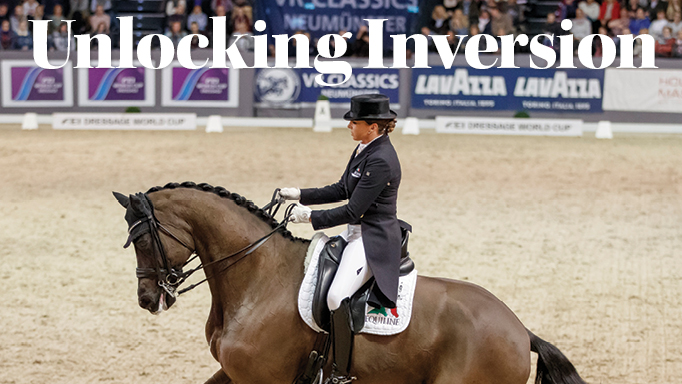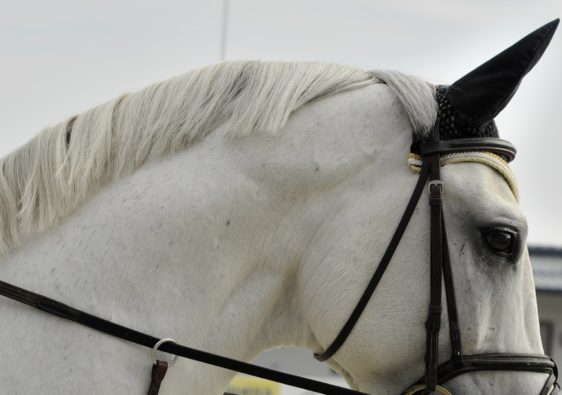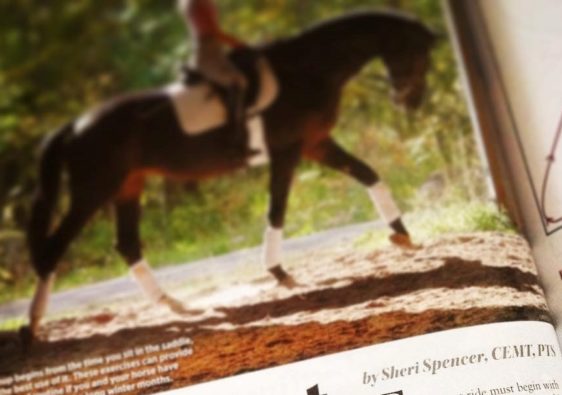A dropped or hollowed back can be a critical roadblock in advancing the athletic development of the horse. More importantly than the sought-after aesthetics, it is a definitive indicator of weakness through the abdominals, and lack of engagement from the hindquarters.
Once ill-fitting tack and pain have been ruled out as potential factors, it’s a matter of targeting the horse’s body in ways that release tension and develop strength specifically in those areas of weakness.
Lateral Bending
Through circling exercises, serpentine and leg yields, the natural bend that is created through the spine helps unlock the topline while encouraging them to step under themselves more with the inner hind leg. Exaggerating this bend for limited periods can be helpful in the early stages to get the point across.
Maintaining a steady rhythm is essential, allowing more time for the hind end to step under versus when the horse is allowed to rush, and that is what will help strengthen the muscles for engagement for progressive training.
Rounded Squares and Diamonds
Squares and diamonds with rounded corners are useful exercises for alternating between creating a lateral bend and straightening. Rounding the corners as if they are quarters of circles affords the opportunity to establish a bend for a few strides before straightening again. For horses who achieve engagement and roundness through the body while circling or bending but struggle to do so on straight lines, this exercise in turn helps develop their self-carriage.
Through the corners are the bending phases, where the rider’s inside leg asks for a deeper inside bend and engagement of the hind leg during the posting phase of the trot. By pushing the horse’s ribs outwards, the inside hind can step under more, thereby lifting through the abdominals, and allowing for softening and elevation through the back, shoulder and base of the neck.
Through the straight sides of the pattern, by asking for the same activity as through the corner, the horse learns to translate the elasticity and softness he has through a bend into movements on straight lines. This technique also helps refine cueing off the rider’s inside leg to mean more than just influencing tempo or gait.
If the horse proceeds through the straight sides desirably after practicing the exercise, it’s a great opportunity to round out the shape onto a circle and allow them to proceed ahead, letting them carry themselves for as long as they’re able, making corrections only as necessary.
With practice, the horse can begin to associate that when cued while their inside hind leg is airborne, it means a deeper step, engagement of the abdominals and a lifting through the back whether through a corner, circle or straight ahead.
Half-Moon
The half-moon is a demanding exercise for more advanced horses that forces them to step under themselves, carrying themselves over the weight-bearing leg rather than being able to move forward off of it. It’s an intense workout for the hindquarters that forces them to carry more weight on their haunches rather than being allowed to tilt their weight forward onto the forehand.
The pattern begins at a halt, generally at the centre of the long side. Imagine that you are halted on the edge of a slice of pie, facing the point, and you’re asking the horse to cross over to the other edge of the pie without walking forward through your hands.
From the outside leg, ask him to step over until his body is roughly at a 45 degree angle from the rail with his hindquarters furthest, and then ask him to move away from your inside leg back to the rail along the same curved track. Stepping forward can be corrected with a backwards step, and then resume.
Twice is generally sufficient, so once you return to the rail the second time, ask the horse to trot on and into a 10 metre semi-circle. Observe the gait and be sure to maintain an even rhythm, as the exercise tends to inspire a lot of power.
If the rein-back is well established, an effective change of rein can be executed as you arch onto the centre-line, ask for a halt and proceed into the schaukel: rein-back 3-4 steps, walk forward 3-4 steps and immediately reverse again while a forefoot is still airborne, then trot on, and after a few steps turn into a 10 metre semi-circle in the new direction.
Halt at the centre of the long side facing the new direction and repeat the exercise off the other leg.
It is a great idea to allow for a trot ahead, letting them reach out onto a long rein after practicing this exercise. Not only does it allow you to assess the efficacy of the lesson through how they carry themselves, but encouraging them to stretch out the topline for body and mind is an essential reward.
The most important things to remember when trying to overcome a dropped or hollowed back is that the strength to correct it must come from the abdominal muscles and hindquarters. The softening and rounding of the neck comes more naturally when then chest is elevated and the back is supported. Practicing exercises that encourage engagement of the abdominals and stepping under with the hind-end will help the horse reach his athletic potential.
Find the complete article as originally published in Horse Sport: Unlocking Inversion




